The following is part of a lecture that we gave for the AIA Middle East CES Course on the topics of Sustainable Design and Regional/Urban Design & Planning.
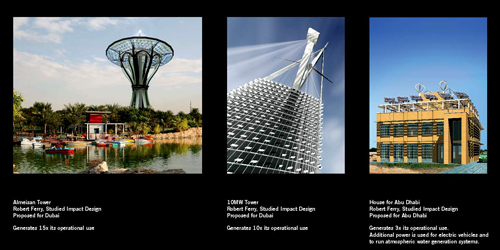
In 2008, we designed a solution for an iconic tower for Dubai (as a part of a design competition) that incorporated the technology of the solar power tower, along with passive cooling chimneys, into the artistic expression of the building. The tower powers itself and Za’abeel Park in which it is conceptually situated. Another design for a mixed-use tower, the 10MW Tower integrates three active systems: concentrated solar power, solar updraft, and horizontal axis wind into a building that produces 10x its operational demand load. The idea of an extreme integration of renewable energy infrastructure into the design of buildings offers a way in which architecture can exist for a third humanitarian purpose.
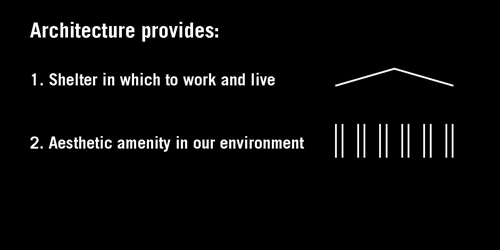
Architecture has served us firstly to provide shelter and functional space within which we work and reside. Its secondary role has been as an aesthetic amenity to our shared and private space. Architecture’s public face has a very important role to play, with every edifice signifying its purpose and declaring its personality, its regard for the public realm, and its relationship to human activities. Some buildings accomplish this function in very serious ways, both classical and modern; others with a sense of irony, but even those that prefer to ignore this role end up making some of the loudest statments.
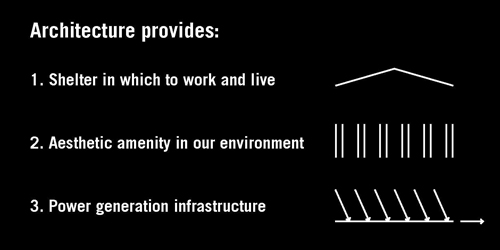
What the technological revolution in renewable energy offers architecture is yet a third purpose which is closely aligned with the first two. While conventional power generation facilities that use coal, natural gas, petroleum, or uranium as their fuel source require large areas of land far removed from population centers, the newer forms of electrical generation do not pollute in their operation and so can be brought back into our urban centers and residential suburbs.
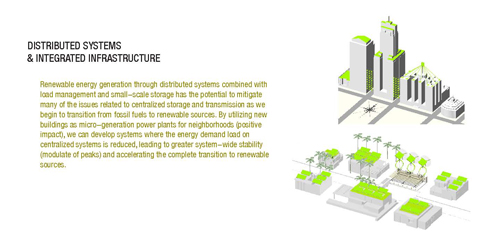
With this shift already occurring in small and medium scale installations, the question is: can new buildings actively participate in the energy generation infrastructure of our cities by producing more power than that which is consumed by their own operation? In essence, the idea of the separate power plant goes away and instead the function is integrated into the commercial and residential constructed environment in a way that shares cost, distributes generation, and allows buildings to pay back their own embodied carbon footprints with the clean energy they provide to the existing city around them.
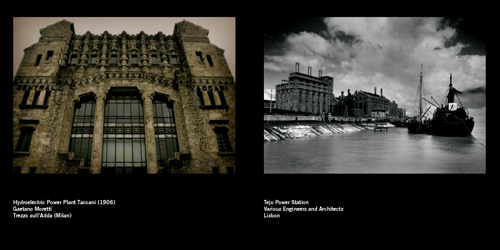
It is interesting to note tangentially here that early in the age of public electrical power utilities (before transformers were able to produce high enough voltage for efficient long distance transmission) fossil-fuel powered generation facilities were by necessity located within urban centers. And in this context, the responsibility towards aesthetic amenity was heeded well.
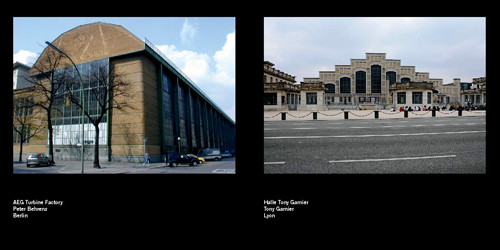
Power plants were designed to fit within the architectural languages of the day, and in fact, their programmatic requirements contributed greatly to the evolution of the art with influence on early modern architects such as Otto Wagner, Tony Garnier, Peter Behrens, and later on, Futurism (via Antonio Sant’Elia) and the Bauhaus.
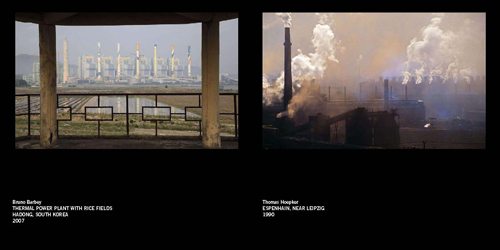
As more and more energy generation infrastructure was able to leave the city behind, it lost its relationship to architecture, especially with regard to that second humanitarian purpose of architecture that we mentioned: public amenity. It became pure utility—something to drive quickly by and hazardous to public health.
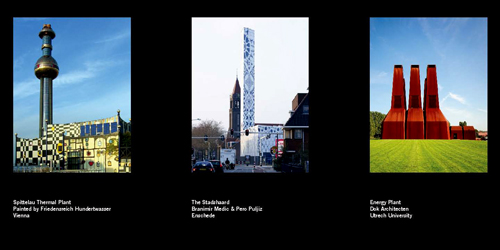
The notable exceptions in the latter half of the 20th century have been in cases in which the facilities remain in more urban settings, such as integrated within university campuses, or substation enclosures within the city.
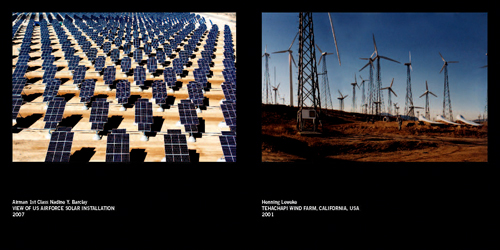
This almost complete divorce of architecture and art from utilitarian power generation infrastructure has in many ways continued into the present as it pertains to utility-scale renewable energy production. In some cases, this has led to push-back within communities that find themselves in close proximity to large-scale utilitarian solar and wind installations.
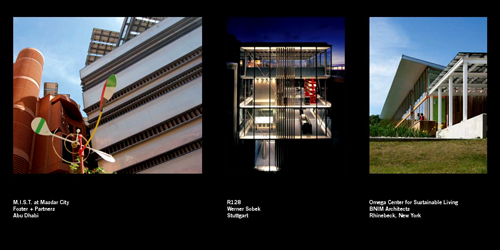
This is less the case with smaller-scale generation, which allows for photovoltaics and small-scale wind applications to be integrated into the building design. BIPV innovation especially has made it possible for designers to provide a percentage of on-site renewable electricity, and in some cases, with the necessary assistance of good passive energy conservation design, provide 100% or more of the operational power requirements, resulting in net-zero buildings and developments.
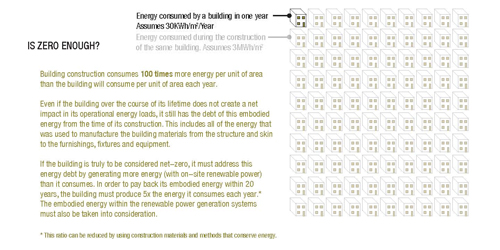
But, as we know, the construction of buildings can consume up to 100 times the energy that the building consumes over the course of one year of operation. What the integration of larger-scale renewable energy systems makes possible is a more true zero-impact status (or what you can differentiate by calling ‘positive impact’) that takes into account all of the energy required to construct, operate, and eventually decommission the facility. Depending on the size of the building, its durability and adaptability, and its initial ecological footprint, the energy generation should be between 3x and 10x the operational use in order to provide a carbon payback period between 15 and 30 years. It will be necessary to establish an interdisciplinary approach to urban planning at the city level that provides incentives for developers to make this type of investment in infrastructural public largesse. But if the proper public policies, smart grids, and feed-in-tariffs are in place, it may be possible that these buildings could become a good return on investment.

There are many who are thinking along these lines, searching for ways of treating renewable energy technology as a design element that can work seamlessly with architectural expression. For the most part, these ideas have been incompatible with existing markets and incentive structures. It is a significant enough investment to construct a building by conventional standards to satisfy the programmatic requirements and smooth operations of the first use. And the cost of energy is relatively inexpensive, which provides disincentive to the proactive adoption of this type of hybrid building.
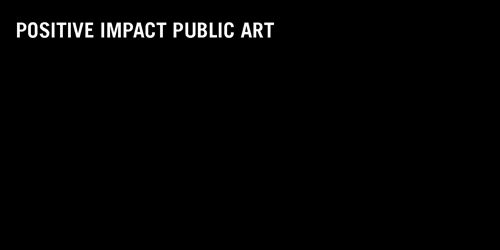
It occurred to us in the autumn of 2008 that there may be an easier adoption of aesthetics with larger-scale energy infrastructure if it were to occur within the genre of public art. Public art serves many purposes. It teaches, inspires, adds pleasure and interest to our days. It generates tourism and increased economic development. It gives us pause to question our assumptions about place, space, materials, and the meaning of things, and it generally strengthens our communities in ways that are innumerable and defy explanation. Can public art do these things and more? There are many examples of crossover between public art and objects of utility.

It is sometimes difficult to draw a clear distinction between landscape architecture and land art (Betsy Damon’s The Living Water Garden in Chengdu, China is a good example: the art-park serves as a bio-filtration water purification system for the river). Sometimes there is a strained distinction between public art and architecture (consider Bernard Tschumi´s Follies in Parc de la Villette Paris, for example). So then what about between public art and energy generation infrastructure?
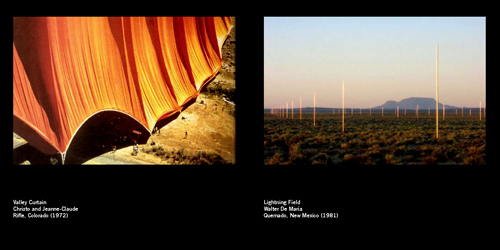
Many traditional works of land art, such as those by Robert Smithson and Richard Long, use only natural materials; but there are others, such as those by Water DeMaria, Michael Heizer, Nancy Holt, Cristo & Jeanne-Claude to name a few, that incorporate synthetic materials (metals, fabrics, concrete) into the works. So, inspired by our love for land art and by the greater proliferation of the integration of renewable energy on-site power generation systems into the eco-millennial architecture of the past decade, we set out to discover how large-scale works of public art could be used as power plants for cities.
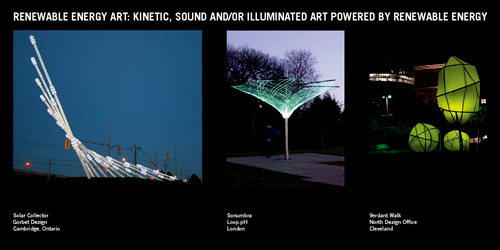
We immediately brainstormed an international design competition. For while we could find some great examples of public artworks that powered themselves with solar panels, there did not seem to be sufficient extrapolation towards a greater fusion between art and this particular type of utility or infrastructure art.
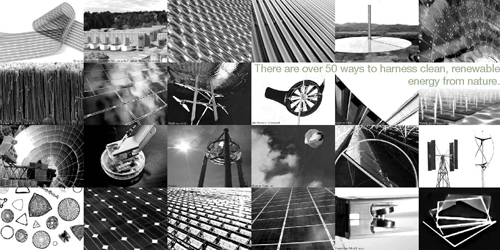
As a part of the Land Art Generator Initiative, we put together an online catalogue of renewable energy generation technologies that we hope can be a source of inspiration to designers who participate in designing land art generators, or who are interested in applications in other contexts. It is important to note is that there is a lot more out there than what we see in the everyday. In fact there are more than 50 different proven methods of harnessing the power of nature in sustainable ways. Some of the more interesting examples that may be applicable as a medium for public art installations are the organic thin films which are flexible and offer interesting hues and textures, piezoelectric generators that capture vibration energy, and concentrated photovoltaics, which allow for interesting play with light. But the possibilities are endless and new designs are coming into the market all the time that can be artistically integrated into large, conceptual installations.
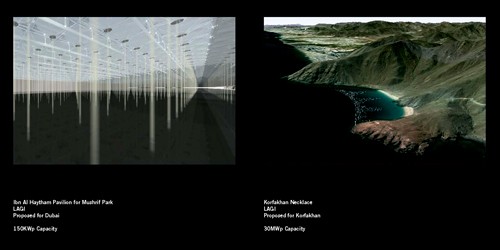
In early 2009, we came up with a few ideas of our own utility-scale energy generating artworks at the start of our planning process in order to explain what it was that we were looking for. One of these provisional concepts incorporated a modification of concentrated photovoltaics, another used artfully placed wave buoys. At the same time we formally established the Land Art Generator Initiative (LAGI) identity and launched the competition on January 15, 2010 at the World Future Energy Summit in Abu Dhabi.
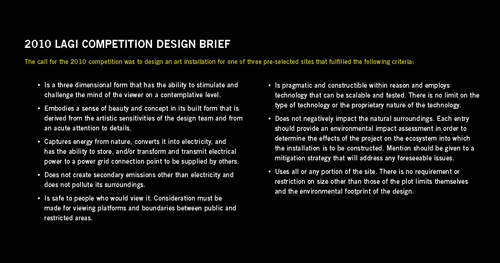
The design brief was fairly simple—the artwork was to capture energy from nature, cleanly convert it into electricity, and transform and transmit the electrical power to a grid connection point to be supplied by the city. Consideration should be made for the safety of the viewing public and for the educational activities that may occur on site. We asked that the design be constructible (rather than theoretical) and that it respect that natural ecosystem of the design sites. We encouraged interdisciplinary collaborations between artists, architects, landscape architects, engineers and scientists.
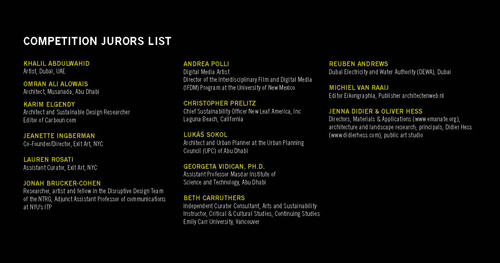
The jury that we put together was as interdisciplinary as the teams that participated, with top professionals from the worlds of art, science, architecture, urban planning, sustainability, and utility. From the UAE, we were very lucky to have Khalil Adulwahid and Omran Alowais. We also were fortunate to have Lukas Sokol with Abu Dhabi Urban Planning Council, Reuben Andrews with DEWA, and Georgeta Vidican from Masdar Institute of Science and Technology.
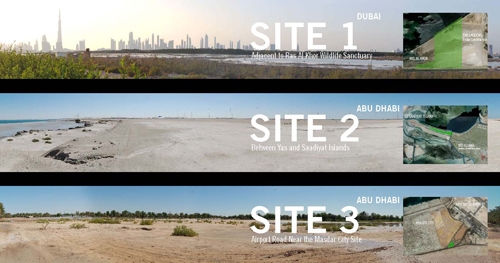
We gave artists the choice between three very large urban sites: one in Dubai and two in Abu Dhabi. The sites were theoretical but they were chosen because they all fit the following three criteria: 1. they are not slated for development in either of the city’s long-term urban plans, 2. they combine the perfect mix of adjacency to natural beauty and proximity to urban areas, and 3. they have ample access to renewable energy resources. We chose sites that would inspire the minds of the design teams, as well as the residents, local stakeholders, and decision-makers of both cities. What is wonderful about the site-specific nature of the project is that the responses to the shifting parameters will yield incredibly diverse results. It is our intention to continue holding the LAGI competition biennially for different locations around the world, and to pursue the construction of the designs in the growing portfolio for cities everywhere. Many of the designs may be adaptable to sites other than the ones that they were originally designed for. We see that many of the works submitted to the 2010 competition are modular or could otherwise be scaled up or down.
Art has a great power to stimulate collective thought and inspire the future, and the context of the LAGI project is somewhat of a perfect storm for harnessing that power to help address some of contemporary society’s most pressing issues. LAGI draws on the rich and continuing history of eco-art, land art, environmental art, art as social practice, new media and tactical media art; and at the same time it benefits from the recent technological breakthroughs in renewable energy science and systems integration that have allowed for the potential of using these new materials as part of the media for the creation of public art. The interdisciplinary process also provides an interesting path to innovation as artists work with scientists on concepts that utilize biomimicry and various creative methods.
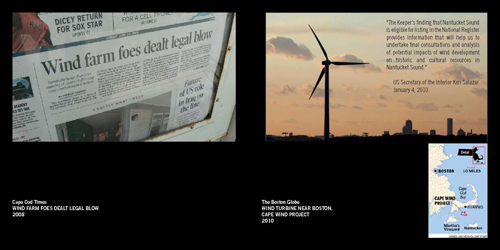
The question that we are asking regarding the aesthetics of renewable energy infrastructure could not be timelier, given the push-back that we have seen on renewable energy installations. Every day there seems to be a new story about people disapproving of solar or wind installations in their communities. It’s not that they don’t care about the environment; in many cases the people opposing the installations are self-avowed environmentalists. To some people, the addition of turbines to the skyline that they can see from their porch is a form of visual pollution.
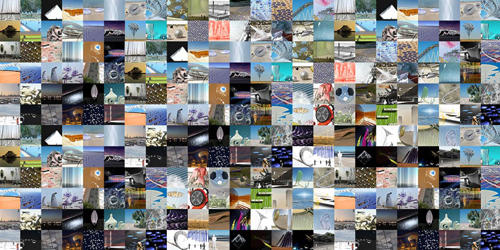
In response to the proposition that renewable energy can be beautiful, the results of the 2010 competition in the UAE have resoundingly proven that this is true with hundreds of innovative artworks submitted from 40 countries. The response has been overwhelmingly positive both here in Dubai/Abu Dhabi, and internationally.
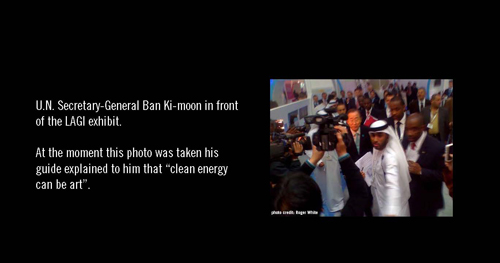
By approaching clean energy generation in this way, The Land Art Generator Initiative will have the effect of broadening the audience that will become engaged in the long-term solution and will help to accelerate public acceptance of renewable energy infrastructure that is integrated organically into the fabric of our social and environmental ecologies.
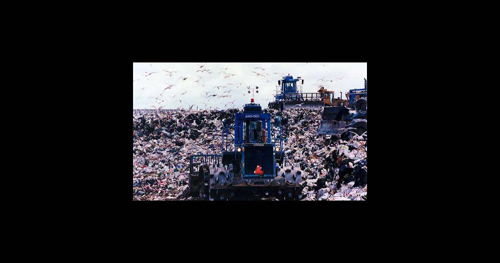
We’re now in the planning stage of the 2012 competition which will take place for a design site within Freshkills Park in Staten Island, New York City. We’ve partnered with New York City’s Department of Parks & Recreation on the project and we are certain that it will be an exciting challenge to artist teams—the interest so far has been very positive since our soft announcement. Freshkills Park offers an interesting and inspirational site. Reading from the official description from Parks & Recreation:
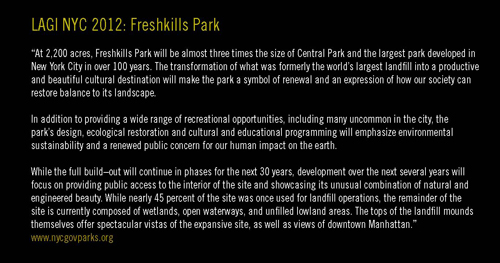
“At 2,200 acres, Freshkills Park will be almost three times the size of Central Park and the largest park developed in New York City in over 100 years. The transformation of what was formerly the world’s largest landfill into a productive and beautiful cultural destination will make the park a symbol of renewal and an expression of how our society can restore balance to its landscape. In addition to providing a wide range of recreational opportunities, including many uncommon in the city, the park’s design, ecological restoration and cultural and educational programming will emphasize environmental sustainability and a renewed public concern for our human impact on the earth.”
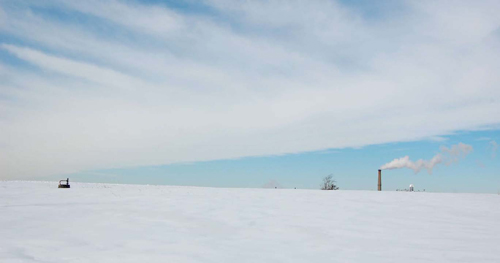
With the generosity of the Freshkills Park administration, we have had the opportunity to visit the site twice and it is really beautiful with captivating views towards the Manhattan skyline.
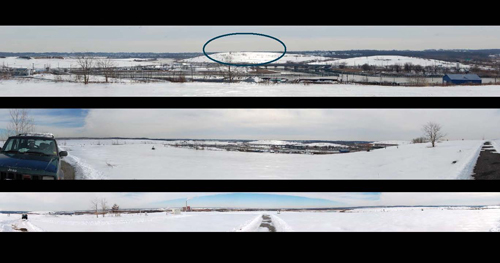
The complete design brief will be released in January of 2012.